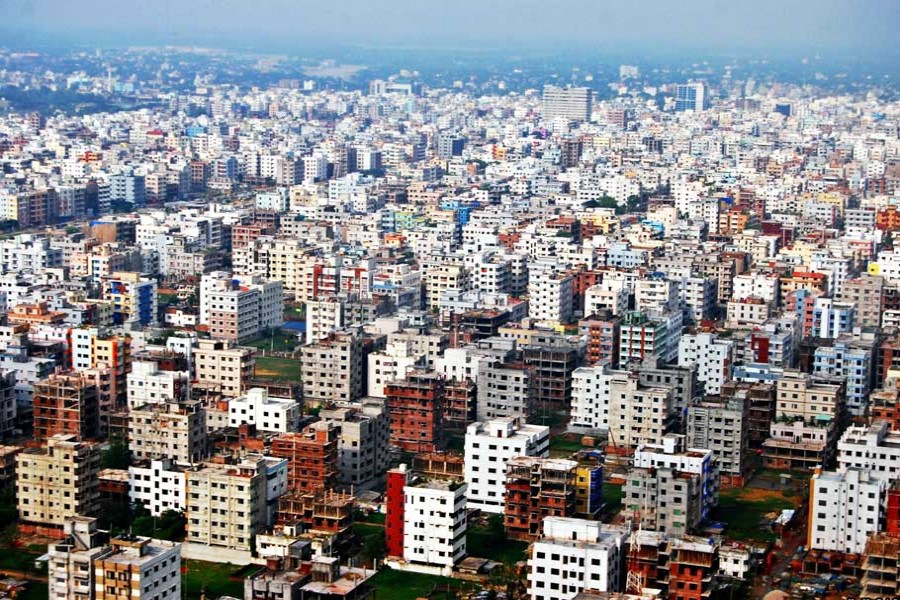
Published :
Updated :

Dhaka was once known as a green city, due to a number of its main roads being lined with majestic trees. Besides, its relatively minor roads also stood out with their green lushness. There were few areas in Dhaka not gifted with smaller trees and parks. Thanks to the indiscriminate felling of trees for the sake of rapid urbanisation after independence, Dhaka continued to become a barren city. The process still continues. Felling trees has become a 'normalised' unlawful act. In many cases, valuable ancient trees are being made to disappear considering them hindrances to road construction, building houses and offices. Both government and private entities are equally eager to go after trees.
A study by the Department of Environmental Science at Jahangirnagar University (JU) says that only 2.0 per cent area of Dhaka now has forest covers. At the same time, according to a study by the Department of Urban and Regional Planning at BUET, the capital needs 20 per cent of green areas. In reality, it has now less than eight and half per cent of green zones. Another study conducted by BUET (Bangladesh University of Engineering and Technology) says the responsibility of the management of Dhaka's green coverage rests with several government and local-government organisations. They include RAJUK, DNCC, DSCC and the Forest Department.
A researcher feels puzzled over how can an area be called a tree-filled one, when the trees of which decrease from 17 per cent to 2.0 per cent. Moreover, it sounds incredible how 70 per cent of these 2 per cent semi-forest areas are located in a single area like Mirpur and its surroundings. In the recent years, Dhaka hasn't taken up initiatives to create urban forestry by planting trees in a planned manner. It sounds strange that the policymakers haven't yet focused on it amply. The basic point is in the times of wide-scale vanishing of trees and forests, many ideal cities have turned to protecting their forests. Those which have started witnessing sharp decline in their woodlands have started reforesting the areas. Restoring the natural or man-made forests can help bring the vegetations back to their earlier form. In a number of highly developed cities, the nearly ritualistic tree plantation programmes are a regular feature. In Bangladesh, trees and forest pockets are regularly wiped out; those areas hardly get back their old look.
Deforestation or decline in vegetation is responsible for around 15 per cent of all greenhouse gas emissions. Greenhouse gas emissions contribute to rising temperatures, changes in the patterns of weather, and an increased frequency of extreme weather events. Irrespective of the sizes of particular areas, the weather events include flooding, excessive rain or drought --- at both large and smaller scales. In the category of smaller scales, the cities of a country stand out quite prominently. With its trees vanishing alarmingly, Dhaka occupies a major place in the world.
Even in the 1970s, the aerial view of the capital from a 4 to 5-storey building used to offer a soothing view filled with trees. From the above, the city back then appeared to have been covered with a blanket of greenery. This view has long been replaced with a concrete jungle. Quite often, one's look remains blocked by tall buildings constructed on the four sides. It's because few apartment owners bother to keep the required space between buildings. As seen in the residential areas in the developed cities, the spaces between buildings are normally filled with trees. Following in the footsteps of Dhaka, the country's smaller cities have started showing apathy towards trees. Instead, whatever patches of naturally grown forests are there, they are cleared to construct concrete structures. Environmental impacts of neglecting trees in a city perspective cannot be undermined. An in-depth study on the subject provides a detailed picture.
It says cities and urban areas are more vulnerable to the growing impacts of climate change. It occurs due to high amounts of paved surfaces, increased pollution, denser human population, and concentration of built structures. It leads to the urban 'heat island' phenomenon, in which urban areas with large amounts of impermeable, heat absorbing surfaces are measurably warmer than the surrounding areas. These areas are particularly those with natural covers. As climate change impacts Earth, it will continue to disproportionately affect urban areas, and the warming will continue. Trees are also used in preventing floods. In the European city of Amsterdam, trees are strategically planted for flood mitigation.
In Dhaka, the powerful quarters habitually get away with felling trees indiscriminately. They bother little about the short-term and long-term impacts of their acts. In short, they continue to remain engaged in activities that discourage the tree coverage of a city being shorn of a great blessing of nature. The most severe damage they inflict on a large urban area is through encouraging others to follow them in their odious act. The general people feel encouraged in felling trees, at times in highly sensitive areas, as there is veritably no legal provision for punishment for the grave offence. Tree Plantation Days, Weeks or events highlighting the benefits gained from of trees are observed annually in the country. These events centre round tree fairs, as well as distribution of saplings as prizes in competitions and festivities. It's only in the recent years that the educated urban middle-class people have started showing interest in the events related to growing trees. This is an auspicious sign.


 For all latest news, follow The Financial Express Google News channel.
For all latest news, follow The Financial Express Google News channel.